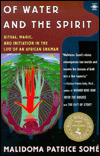Of Water and the Spirit
by Malidoma Patrice Somé. Penguin USA, 1995.

Malidoma Patrice Somé was born in Burkina Faso, in the country of the Dagara people. He lived in the village of Dano until the age of five, when he was kidnapped by a French missionary priest. After fifteen painful years of reeducation in a parochial school, Malidoma escaped and made his way back to his village, where he found himself unable to speak the language of his people. His alien education had made him a dangerous element in the village, the elders feared, and because he had never been initiated he could not take his place as an adult Dagara. Only initiation could make it possible for him to stay, but the psychic changes he had undergone meant that initiation would be an even more hazardous passage for him than for most young men.
The bulk of this vivid memoir deals with Malidoma's initiation experience. His account offers a rare glimpse into a closely guarded series of rituals: guarded not only because of traditional taboos against the inclusion of outsiders, but because almost no one who has moved from an oral to a written culture has taken part in one, and can describe what happens to a Western audience. Literacy, Malidoma suggests, is almost directly opposed to the nonlinear understanding that initiation imparts. In fact, he comes to believe, "literacy, from the traditional point of view, occupies a space within the psyche that is reserved for something else." Malidoma stresses the great difficulty of rendering his experience in words, and admits that he has been been forced to "trick" the reader by withholding certain things the elders have forbidden him to reveal. But what remains is mind-boggling enough.
Malidoma describes a series of journeys into alternate worlds that each boy (though Malidoma is twenty years old, the others are around thirteen) must undertake. In one of these, each of them must jump into a "light hole" magically created at the center of a buffalo skin stretched tight over a circle drawn on the ground with ash and "black medicine." The boys are told that once inside they will find themselves falling through space, and must open their eyes before they fall too far and stop themselves by grabbing one of the many colored filaments running alongside them. As Malidoma waits for his turn, he sees one boy after another disappear into the light hole. A few minutes later the elders lift and toss the skin, ejecting a ball of violet surrounding each boy's body. Most of the initiates beat the violet flames from their bodies and walk off unharmed, but one boy returns lacerated and screaming, lies for a while in a pool of greenish fluid that gradually coagulates, then turns rigid in death.
Readers of this book, like readers of Carlos Castaneda's books about the Yaqui Indian sorceror Don Juan, must decide for themselves whether they consider it a truthful account of a spiritual quest, a remarkable work of fiction, or some combination of the above. Malidoma compels belief, however, in the seamless way in which he merges ordinary occurrences with seemingly bizarre or impossible ones. His years at the Catholic seminary are described with as much care and apparent interest as the strange events that surrounded his initiation, because those years too are an important part of his journey. Even the apparent silliness of some of his visions, like the talking rabbit he encounters as a child, add to his seeming veracity, and he is perfectly willing to discuss the dirt-encrusted skin of certain elders, and their terrible smell -- an indication of their indifference to the things of this world. As a writer and speaker who has spent years mediating between the Western world and the world of the Dagara, Malidoma must know that many readers would find the solemn and impressive visions more believable if he suppressed the apparently silly ones, and it seems significant that he does not choose to do so.


